|
|
|
|
|
|
|
I love this region! |
|
|
Note: You can enlarge the images by clicking on them. |
A flood of images and impressions. A world of colours. Forests scented by pine and mushrooms. Silver-lined rivers and streams running to parts unknown. Beautiful, picturesque towns, villages and hideaways. Majestic castles and elegant chateaus. A landscape enriched by varying natural scenery and man-made monuments. Paradise for water fowl, fish, fishermen and lovers of water sports. Locales where history has been made.
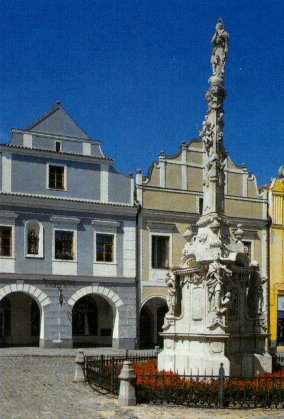 Trebon |
The heart of southern Bohemia beats in Ceske Budejovice, the ancient royal city with many unrivalled buildings and historical monuments. It was founded in 1265 to fortify the monarch's influence in the southern region controlled by the powerful aristocratic family, the Rosenbergs. The city has maintained its royal lustre and charm. The main city square running 133 meters (approximately 146 yards) long on each side makes an unforgettable impression. The pure Gothic and Renaissance style bourgeois homes contrast with the richly decorated baroque town hall with its three tower facade. Ceske Budejovice is known not only as an architectural gem, but has also become a Mecca for admirers of the world renowned Budweiser beer.
If Ceske Budejovice is the heart of southern Bohemia, then its spine is undoubtedly the Vltava river. Along its banks rest many of the region's important sights. Upstream and south of Budejovice is the early Gothic Cistercian monastery Zlata Koruna (Golden Crown). It was founded in 1263 by King Premysl Otakar II in celebration of the victory at Kressenbrunn. Zlata Koruna is typical of southern Bohemian Gothic architecture, its western facade's portal and windows being pure examples. The magnificence of its chapter hall is emphasised by the vault's two slender pillars. Among the oldest structures in good condition is the two-storey Chapel of the Guardian Angels dated from the end of the l3th century.
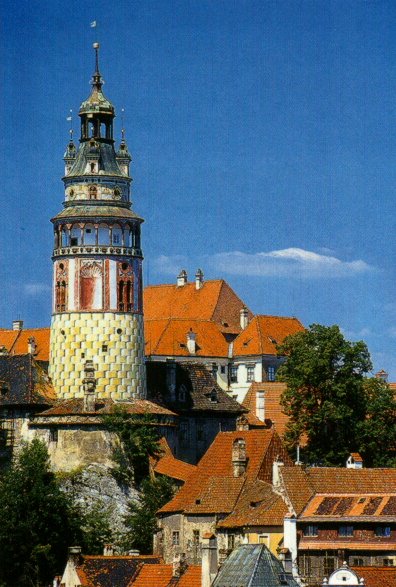 Cesky Krumlov |
In a romantic valley between the picturesque curves of the Vltava river lies one of the most remarkable southern Bohemian cities - Cesky Krumlov. It is a petrified fairy-tale. Meandering, narrow lanes. Homes with vaulted gables, bay windows and arches. Strange towers and turrets. The riches of the Gothic and Renaissance ages. Gazing down on all this from steep rocks is the exciting silhouette of the massive castle founded in the mid-l3th century by the Rosenbergs. During their 300-year reign Cesky Krumlov experienced its greatest era. In subsequent years building rather stagnated and hence the city's medieval appearance has been preserved. On account of its unique and invaluable historical significance, Cesky Krumlov was placed on the Heritage List of International Cultural and Natural Sites by UNESCO.
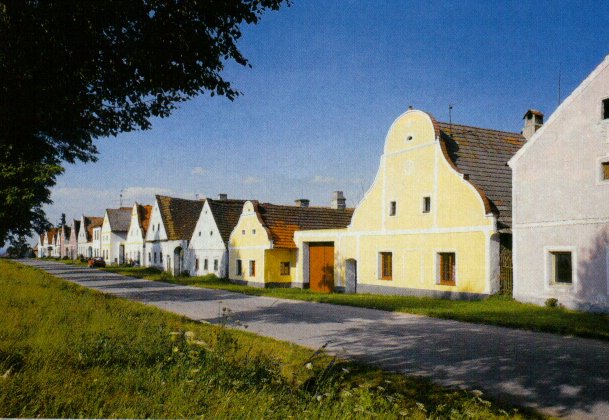 Typical South-Bohemian Village (Holasovice) |
Castles are an ubiquitous part of the southern Bohemian landscape. Their characteristic moss-covered battlements adorn many hills and stone walls grow out of hillside rocks. The Rozmberk castle stands on a narrow rock inlet reflected by the calm depths of the Vltava since the l3th century. It is the cradle of the large aristocratic family with the five-petalled rose coat of arms whose power and wealth competed with that of the Bohemian kings. The bay windows afford breathtaking views of the charming town and its church. The exquisite castle interiors with their panel ceilings shelter an extensive collection of paintings by Czech baroque masters as well as baroque and Renaissance furniture and tableware. Shrouded in tales and legends the castle even has its own (good) ghost - White Lady - whose portrait hangs in what is called the Rosenberg Room.
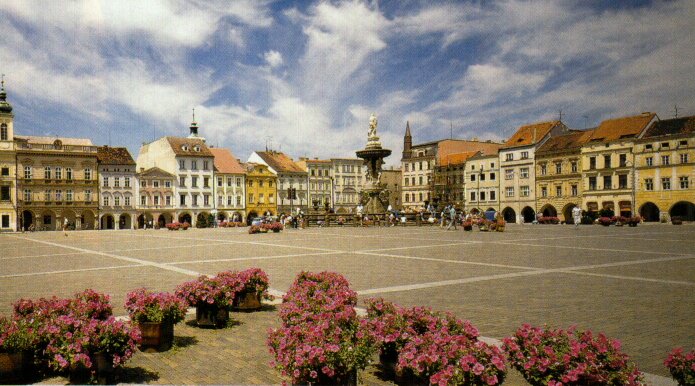 Ceske Budejovice |
The most valuable monument on the upper reaches of the Vltava is the Cistercian monastery in Vyssi Brod. It was founded in 1259, according to legend as thanks to God for the miraculous rescue of one of the Rosenbergs. Its appearance today hails from the l9th century. The monastery's Gothic core is formed by its chapter hall and basilica with transversal naves and chapels. The library is housed in a beautiful baroque room and contains 70,000 titles. Admirable as well are the square's Gothic structures reconstructed in Renaissance, baroque and classicist styles.
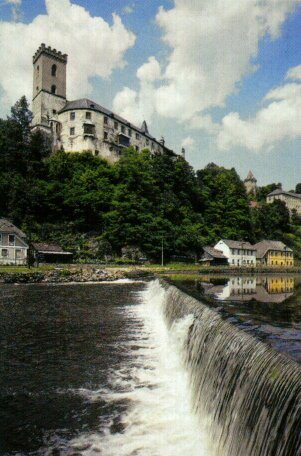 Rozmberk Castle |
Vyssi Brod is sought-after by water lovers, who begin their wanders along the Vltava here. Lovers of natural wonders explore the nearby Devil's Wall, a site infused with myths and fables. The bizarre rock formations were created by granite eroded into blocks making a fascinating "stone sea'.
The rapids, pools and streams of the upper reaches of the Vltava disappeared in the 1950s under the Lipno dam. The sparkling silver surface of the water fulfils every dream of fans of water sports.
The southern Bohemian Blata region is full of melancholy magic. It fans out from the right bank of the Vltava north-east of Ceske Budejovice. The villages' distinctive and typical southern Bohemian baroque l9th-centuiy farm structures are the work of simple village craftsmen influenced by the architecture of the homes of the bourgeoisie and nobility.
 Cervena Lhota Chateau |
Through a pink mist the water's dark surface reflects the Cervena Lhota chateau, to all appearances a vision from a magical fairy-tale.
At the beginning of the l7th century the last of the Rosenbergs, a temperamental admirer of life named Petr Vok, moved to a chateau in Trebon. Up until today Trebon has preserved its original medieval plan, fortifications and gates, as well as numerous Gothic and baroque structures, for which it has been identified as a protected urban monument. It is, however, a modern city with a rich cultural life and due to its extensive reserves of quality medicinal mudbaths Trebon is as well an important spa centre for those with motor difficulties.
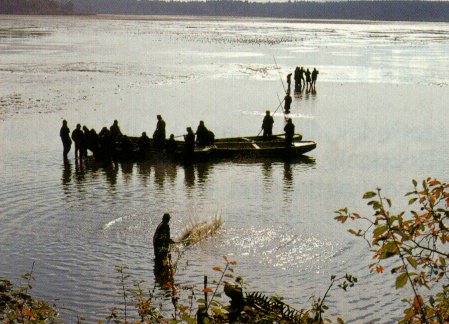 Fishermen |
In the l6th century southern Bohemia's most famous fisherman Jakub Krcin from Jelcany and Sedlcany resided in Trebon. He established a series of new ponds, among them Svet (the World), not far from the city, and the largest southern Bohemian pond, the Rozmberk. The technical perfection and environmental sensitivity of the unique system of ponds, dikes, feed and drainage canals are astonishing even today. It is said that Krcin was a cantankerous, sometimes mean-spirited man, but he left behind a grand and wondrous creation.
Following the Vltava�s current to the north of Ceske Budejovice one finds the Hluboka chateau situated above a forest valley in the centre of a well-maintained park. The pure white, three-storey chateau converted to the neo-Gothic romantic style of the l9th century is the pearl in the crown of southern Bohemia ... and brings us to a full-stop in our travels.
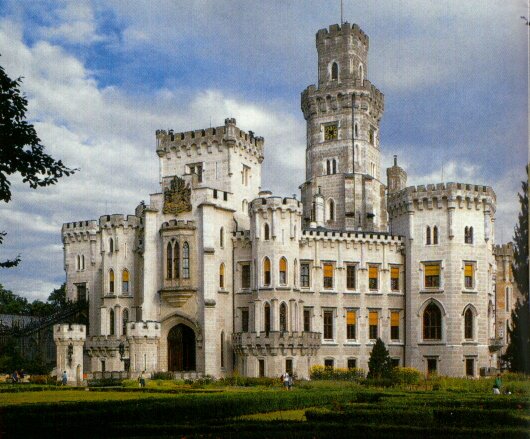 Hluboka Chateau |